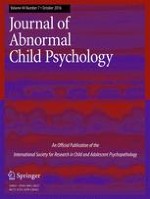18-01-2016
Bidirectional Associations Between Externalizing Behavior Problems and Maladaptive Parenting Within Parent-Son Dyads Across Childhood
Gepubliceerd in: Research on Child and Adolescent Psychopathology | Uitgave 7/2016
Log in om toegang te krijgenAbstract
Coercive parent–child interaction models posit that an escalating cycle of negative, bidirectional interchanges influences the development of boys’ externalizing problems and caregivers’ maladaptive parenting over time. However, longitudinal studies examining this hypothesis have been unable to rule out the possibility that between-individual factors account for bidirectional associations between child externalizing problems and maladaptive parenting. Using a longitudinal sample of boys (N = 503) repeatedly assessed eight times across 6-month intervals in childhood (in a range between 6 and 13 years), the current study is the first to use novel within-individual change (fixed effects) models to examine whether parents tend to increase their use of maladaptive parenting strategies following an increase in their son’s externalizing problems, or vice versa. These bidirectional associations were examined using multiple facets of externalizing problems (i.e., interpersonal callousness, conduct and oppositional defiant problems, hyperactivity/impulsivity) and parenting behaviors (i.e., physical punishment, involvement, parent–child communication). Analyses failed to support the notion that when boys increase their typical level of problem behaviors, their parents show an increase in their typical level of maladaptive parenting across the subsequent 6 month period, and vice versa. Instead, across 6-month intervals, within parent-son dyads, changes in maladaptive parenting and child externalizing problems waxed and waned in concert. Fixed effects models to address the topic of bidirectional relations between parent and child behavior are severely underrepresented. We recommend that other researchers who have found significant bidirectional parent–child associations using rank-order change models reexamine their data to determine whether these findings hold when examining changes within parent–child dyads.
